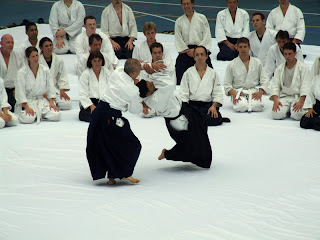 This first entry of 2008 comes with the swish of waves lapping on the Camps Bay shore at 10h30, the feel of fine sand between my toes and the gentle heat of the UV rays on my shoulders ensuring that my natural brown goes even more bronze... Ahh the joys of modern mobile telephony...
This first entry of 2008 comes with the swish of waves lapping on the Camps Bay shore at 10h30, the feel of fine sand between my toes and the gentle heat of the UV rays on my shoulders ensuring that my natural brown goes even more bronze... Ahh the joys of modern mobile telephony...Last night on the mat we practiced a number of techniques, including a fairly basic shiho-nage (4-corner throw) from katate-dori. Imagine, if you will, you are in left hanmi; your attacker reaches out to grab your left hand, whilst preparing to strike you with his right hand. You step in a rearward circle, drawing your left foot back and to a position 270 degrees to its previous position. This draws your attacker (uke) into the signature circular movement of aikido. You draw your hands to your centre, collect uke's outstretched wrist, raising it to your forehead before stepping forward, swiveling and throwing uke to the ground.

The circular movement makes a lot of sense: the hub of a wheel moves very little, while the outer rim has to move relatively, faster and further. Keeping uke then on the periphery of the circular movement forces uke to work harder to keep up.
While this is a fairly basic technique, it was that moment of quiet just before you raise your arms that struck me last night.
In that moment, as uke is coming around, centripetal and centrifugal forces conspire to cause gravity to lose its dominion and a curious lightness, even weightlessness seems to envelop both parties.
 Minegishi sensei (6th dan) exhorted us at the recent AFSA 30th anniversary celebration training to look for that moment before uke settles back into posture. That is the moment to make one's move. Wait too long and you allow uke to regain his/her balance which you have worked to unsettle. Things become solid, staid, heavy and hard to move. Find that moment and your subsequent movements become light and effortless.
Minegishi sensei (6th dan) exhorted us at the recent AFSA 30th anniversary celebration training to look for that moment before uke settles back into posture. That is the moment to make one's move. Wait too long and you allow uke to regain his/her balance which you have worked to unsettle. Things become solid, staid, heavy and hard to move. Find that moment and your subsequent movements become light and effortless. Finding the moment requires that you are completely present in the moment, that you are aware of everything that is happening between you and uke in that moment. You can only get there if you do not hold onto any one thing, but rather "listen" to everything happening - with your whole body.
Finding the moment requires that you are completely present in the moment, that you are aware of everything that is happening between you and uke in that moment. You can only get there if you do not hold onto any one thing, but rather "listen" to everything happening - with your whole body.it is also in that moment of quiet when all is still that the myriad possibilities of techniques or responses are revealed.
In Aikido, we are constantly looking for an opening, a physical gap into which tori can step or uke
 can fall. It is equally important to find that other gap where time and gravity stand still, and where softness resides. That is what takes your movement from technical proficiency to true artistry.
can fall. It is equally important to find that other gap where time and gravity stand still, and where softness resides. That is what takes your movement from technical proficiency to true artistry.TS Eliot put it far better,and far more succinctly:
At the still point of the turning world. Neither flesh nor fleshless.
Neither from nor towards; at the still point, there the dance is....
Off the mat too, finding that elusive space of perfect stillness and quiet among the hubbub of our daily life, is also essential. Too much of our lives is spent reacting to events or stimuli, in
 knee-jerk reactions to things that happen without interposing or finding that moment of quiet to truly evaluate what is occuring. And then responding appropriately.
knee-jerk reactions to things that happen without interposing or finding that moment of quiet to truly evaluate what is occuring. And then responding appropriately.On the mat this results in a less than satisfactory technique or a painful experience for uke; in our daily lives it may also result in painful regrets or recriminations. The magic of the still point, and of the creativity locked within it and the range of choices it offers us, takes us from subsisting to truly living. In the same way that it uplifts your technique from being technically good to truly artistic, so too it permits us to experience the artistry of living a life more fulfilled.
 So if you excuse me now, I'm off to find my own personal still point as the icy aquamarine Atlantic snatches my breath away as I dive into her embrace....
So if you excuse me now, I'm off to find my own personal still point as the icy aquamarine Atlantic snatches my breath away as I dive into her embrace....See you on the tatami soon
Ghalib
1 comment:
This is great info to know.
Post a Comment